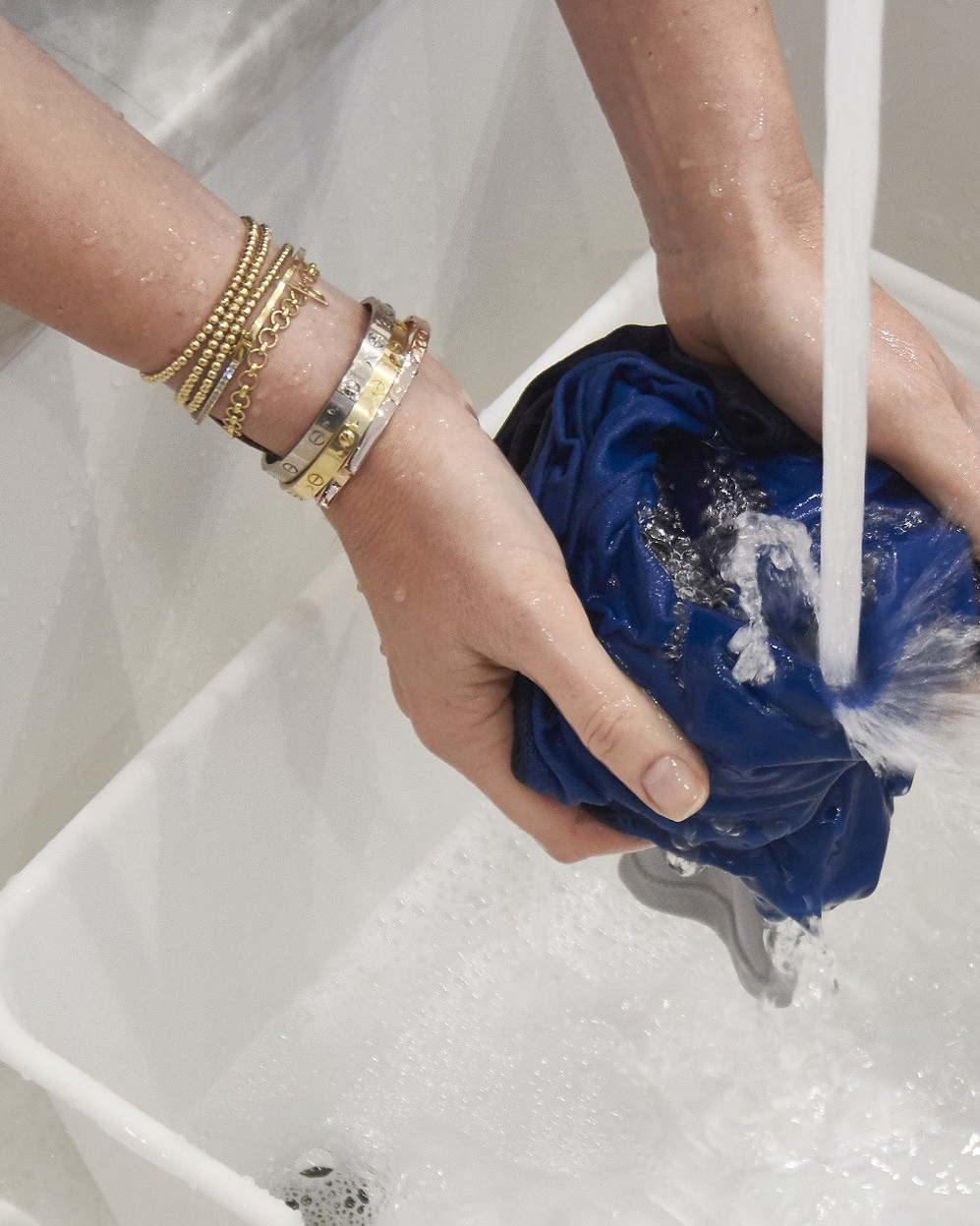
Shop This Look
How to Care for Cashmere—without Going to the Dry Cleaner
Our knitwear designer and product development expert share their tips for caring for the softest of sweaters.
When I think about cashmere, I think about softness, comfort, and most of all, luxury. It’s lightweight and airy, yet incredibly warm; it’s soft and cozy without feeling bulky; and it has a beautiful, smooth texture that makes it look ultra elevated. But despite my admiration for cashmere, I spent years avoiding it, because I was reluctant to commit to something I’d have to dry clean—one of those annoying errands that I tend to put off until my laundry pile is double the size of my remaining wardrobe.
However, when M.M. started carrying products from The Laundress, and I discovered that cashmere can be hand washed at home (!), I immediately stocked up on our newest cashmere turtlenecks, cardigans, and pullovers—and never looked back. And because my gorgeous new cashmere pieces deserve only the best, I turned to the experts for help: M.M.’s knitwear designer, Annie, and senior product development manager, Shelby. Here’s how they recommend caring for your cashmere.

How to Care for Cashmere
When to Wash Your Cashmere
We know you’re an overachiever, and we love that about you. But sometimes less is more, and that’s definitely the case when it comes to washing your cashmere. How often you need to wash your cashmere piece will depend on your body chemistry, the time of year, and whether or not you recently wore it to Korean barbeque. But the bottom line is that you don’t need to wash cashmere every time you wear it—and if you give it a few spritzes of wool and cashmere spray in between wears, you can go even longer between washes.

How to Hand Wash with The Laundress Wool & Cashmere Shampoo
Yes, shampoo! Because, weird as it sounds, cashmere is just hair—specifically, the ultra-fine hair of goats from Inner Mongolia. When it does come time to wash your cashmere sweaters, you can skip the dry cleaner (and the harsh chemicals that usually come with it) by following these steps:
1. Put your cashmere piece in a large basin or sink, and fill it with cold water. (Using warm or hot water can cause felting—which leads to pilling—and shrinkage. No, thank you!)
2. Add a small amount (1-2 capfuls) of The Laundress Wool & Cashmere Shampoo. Gently swish the garment around in the soapy water to distribute the shampoo, then let it soak for about 10 minutes. Never soak your knits or delicates for more than 30 minutes.
3. Drain the basin, then refill it with clean, cold water. Gently rinse your piece in the clean water without agitating it too much (a few gentle swishes will do), then drain the water again.
4. Lay your cashmere piece flat on a clean towel, then roll it up and carefully squeeze to get out excess water (Shelby points out that you should never wring out your knits). Unroll the towel, then lay flat to finish drying. Note: Thicker yarns such as plush cashmere will take longer to dry than most pieces—be patient!
Want more M Dash?
Sign up for our weekly newsletter.
Thank you!
Can Cashmere Be Dry Cleaned?
Yes! And while most of your cashmere care can be done at home, major stains or strong smells (like from that Korean barbeque dinner I mentioned earlier) should be handled by a professional. If you get a stain on your cashmere piece, bring it to the dry cleaner as quickly as possible, and tell them what created the stain. If you’re not confident you can get it out yourself with stain remover, don’t risk it—trying to remove a stain incorrectly will only make it harder for the dry cleaner to get out.
While not necessary, dry cleaning your cashmere at the beginning and end of sweater season will help with longevity and make your pieces feel fresh. Think of between-season dry cleaning like getting a facial—you can do all your skincare at home, but it’s nice to get a professional tune-up every once in a while.

How to Handle Pilling
When it comes to cashmere, pilling isn’t something you need to fear. Cashmere is constructed from tiny, interlocking loops that rub against one another, so eventually, all cashmere will pill. However, pilling on cashmere is easily treated and doesn’t mean your garment is ruined. According to Annie, cashmere is like a fine wine, and will get better over time (as long as you store and care for it correctly).
When pilling occurs, use a sweater stone to gently remove the pills. If they don’t all come off, don’t force it—they might just need a bit more time to loosen up. De-pilling every so often will help with longevity (and is also pretty therapeutic, if you ask me). The longer you have and care for your cashmere, the less it will pill, kind of like a new rug that needs to be vacuumed less over time.
How to Store Your Cashmere
If you remember one thing from this guide, it should be this: cashmere and hangers are not friends! Cashmere pieces—and all knits, for that matter—should be folded to avoid stretching. If you’re packing up your sweaters for the summer, first treat them with wool & cashmere spray that contains cedar, which will keep your cashmere fresh and moth-free, and then store them in a dry place. For extra insurance, you can always add a cedar block to your storage bin.
Happy sweater season!








